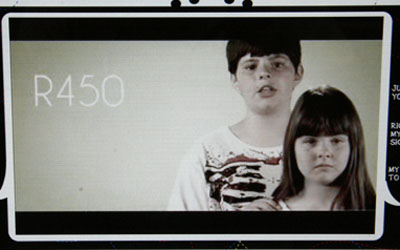
|
One of the most striking parts of the video is when a boy has his hands on the shoulders of a girl
who looks like she could be his sister and explains that for sixty rand, a woman or child is
typically sold to fifteen men a day. The girl adds that both of these figures are the going rate,
giving a chilling visual to the kind of impact that would have on that young girl. The fact that
this girl, along with all of the others, fits in better with my American idea of a "normal" kid,
that is she is white, with long brown hair and a generic t-shirt, and thus jars my expectations
surrounding the slave trade of children. My surprise demonstrates the subconscious way that I think
about race and class, since I would not be surprised with an image of small, non-white children who
appear poor. The video calls for reflexivity when it comes to who we expect slaves to be.
|

|
The methodology of psychoanalysis "suggests that such a fully rational procedure...is an impossible fantasy" (Rose 112). The interactions between audience and video in this case show that the subjectivity of meaning does have much to do with the unconscious, because the way that people understand the information presented will be affected by the fact that it is presented by children. By using children to talk about modern day slavery, the video draws a striking connection between the information being stated and the images of children. The children in the video present sophisticated and disturbing facts about human trafficking and the sex trade, facts that are not normally shared with children. It upsets cultural norms as to the knowledge to which children are exposed. Also, since the viewers are most likely older than the children in the video, an element of guilt is introduced since children are educating the audience. If children know the shocking facts, shouldn't we?
The video states that the majority of trafficking victims are women and children, giving greater salience to the information since children say it. However, people may have different reactions to the use of children in the video based on their feelings about children. It is possible that some may not take the information seriously because children present it, or that those viewers who have children would be deeply affected by the video, despite the fact that no harm is being shown to those children and it is an informational video.
Besides making a commentary on cultural expectations of age, the video speaks to gender roles and associations. Though some of the older girls are depicted as strong and active, for the most part, the boys are portrayed as the protectors in the video. Several of the older boys take the role of the older brother or guardian, especially since it is the boys who express more anger over the situation. The girls give information and are obviously troubled by it, but it is the end that most clearly enforces gendered ideas of who fights back. One of the older boys says, "I think, yes I think, that I'm going to do something about it." His courage and passion deserves commendation to be sure, but the girls should not be portrayed as passive victims to be protected because it enables the very mentality that sex slavery attempts to promulgate.

